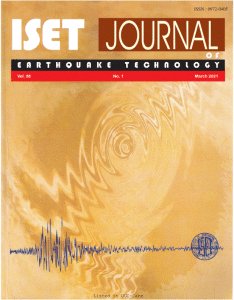Home > Issues & Journals
STRONG MOTION: ANALYSIS, MODELLING AND APPLICATIONS
Prof. R.N. Iyengar
Paper No.: 370
|
Vol.: 34
|
No.: 4
|
December, 1997
|
pp. 171-208

Abstract
Prof. R.N. Iyengar Director, CBRI, Roorkee – 247 667. Earthquakes, their occurrence and their effects on natural relief and man made structures has been a topic of concern to humanity for a long time. However it is only in recent years that major breakthrough have been achieved in the scientific and engineering understanding of earthquakes. One such significant development has been in the recording of ground motion very near the epicenter referred to as _trone motion. Seismologists had been recording signatures from earthquakes at long distances to estimate the magnitudes of the events and the elastic properties of the intervening medium. Engineers on the other hand are inte!”ested in the safety of the structures already built and those yet to be built in the felt region. Thus, emphasiS on collecting and understanding ground vibration characteristic near the epicenter is more prevalent in engineering literature. This is not to say that nearsource (or near field) motion, as strong motion is sometimes referred, is not of interest to Seismologists. Ground motion records from the epicentral region are of great help in understanding the source mechal1ism at the fault level. The approach of the engineers has been somewhat empirical with the focus being safe design of structures. On the otherhand the approach of Seismologists has been less empirical and more mechanistic. Both the approaches have lead to many useful results. However the present talk will be mainly from the engineering point of view.
The outline of the presentation is as follows. After a brief historical review. certain aspects of characterization of strong motion data are discussed. This is followed by a review of empirical stochastic models for strong motion acceierograms. After a presentation on the direct models based on accelerograms, indirect models based on the effect of earthquakes on structures are considered. The concepts of spectrum compatible accelerograms and spectrum compatible power spectrum density (PSD) are presented. The application of the models are highlighted by way of a few real life examples. Progress in earthquake engineering has been closely linked with how well we understand strong ground motion. Recently some new initiatives have been taken in this direction at the Central Building Research Institute. These are briefly presented towards the end of the talk.
Keywords: Not Available
©2025. ISET. All Rights Reserved.